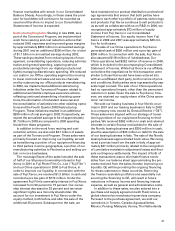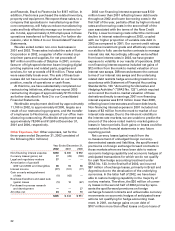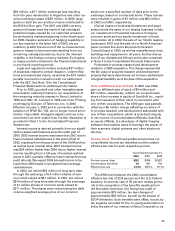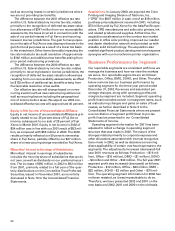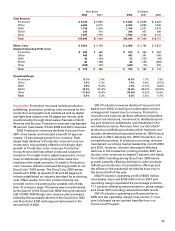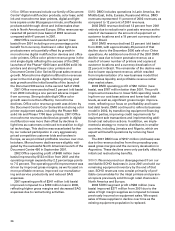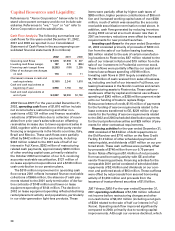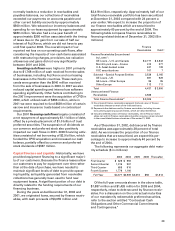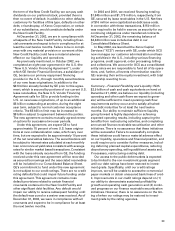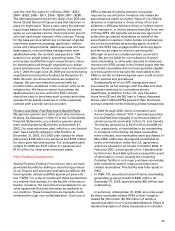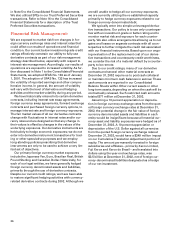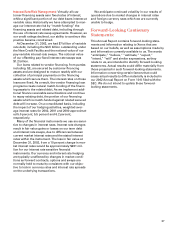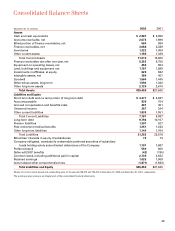Xerox 2002 Annual Report Download - page 32
Download and view the complete annual report
Please find page 32 of the 2002 Xerox annual report below. You can navigate through the pages in the report by either clicking on the pages listed below, or by using the keyword search tool below to find specific information within the annual report.
30
The following table summarizes our secured and
unsecured debt as of December 31, 2002:
New Credit Facility – debt secured within
the 20 percent net worth limitation $ 875(1)
New Credit Facility – debt secured
outside the 20 percent net worth limitation 50
Debt secured by finance receivables 3,900
Capital leases 40
Debt secured by other assets 90
Total Secured Debt 4,955
New Credit Facility – unsecured 2,565(1)
Senior Notes 852
Subordinated debt 575
Other Debt 5,224
Total Unsecured Debt 9,216
Total Debt $14,171
(1) The amount of New Credit Facility debt secured under the 20 percent
consolidated net worth limitation represents an estimate based on
Consolidated Net Worth at December 31, 2002 and the amount of other
debt, as defined, secured under the 20 percent limitation. Any change to
the amount indicated would correspondingly change the amount of the
unsecured portion of the New Credit Facility.
Liquidity, Financial Flexibility and Funding Plans:
We manage our worldwide liquidity using internal
cash management practices, which are subject to (1)
the statutes, regulations and practices of each of the
local jurisdictions in which we operate, (2) the legal
requirements of the agreements to which we are
parties and (3) the policies and cooperation of the
financial institutions we utilize to maintain such cash
management practices. In 2000, our operational
issues were exacerbated by significant competitive
and industry changes, adverse economic conditions,
and significant technology and acquisition spending.
Together, these conditions negatively impacted our
liquidity, which from 2000 to 2002 led to a series of
credit rating downgrades, eventually to below invest-
ment grade. Consequently, our access to capital and
derivative markets has been restricted. The down-
grades also required us to cash-collateralize certain
derivative and securitization arrangements to prevent
them from terminating, and to immediately settle
terminating derivative contracts. Further, we are
required to maintain minimum cash balances in
escrow on certain borrowings and letters of credit. In
addition, the SEC would not allow us to publicly regis-
ter any securities offerings while their investigation,
which commenced in June 2000, was ongoing. This
additional constraint essentially prevented us from
raising funds from sources other than unregistered
capital markets offerings and private lending or equity
sources. Consequently, our credit ratings, which were
already under pressure, came under greater pressure
since credit rating agencies often include access to
capital sources in their rating criteria.
While the 2002 conclusion of the SEC investigation
removed our previous inability to access public capi-
tal markets, we expect our ability to access unsecured
credit sources to remain limited as long as our credit
ratings remain below investment grade, and we
expect our incremental cost of borrowing will remain
relatively high as a result of our credit ratings and
could potentially result in our having to increase our
level of intercompany lending to our affiliates.
Our current ratings are as follows:
Senior Senior Corporate
Secured Unsecured Credit
Debt Debt Rating Outlook
Moody’s B1 B1 B1 Negative
S&P BB- B+ BB- Negative
Fitch BB- BB- BB- Negative
As a result of the various factors described above, in
2000 we abandoned our historical liquidity practice of
repaying debt with available cash and relying on low
interest commercial paper borrowings. Instead, we
have been accumulating cash in an effort to maintain
financial flexibility. We expect to maintain a minimum
cash balance of at least $1 billion on an ongoing basis.
Financing Business and Restructuring: In 2000, as part
of our Turnaround Program, we announced our intent
to exit the financing business, wherever practical, in
order to reduce our consolidated debt levels and
accelerate the liquidity within our finance receivable
portfolios. We altered our strategy in 2002, announc-
ing plans to securitize our finance receivables, thereby
retaining the customer relationship and financing
income.
Other Turnaround initiatives included selling cer-
tain assets, improving operations, and reducing annu-
al costs by over $1 billion. These initiatives are
expected to significantly improve our liquidity going
forward. We have (1) securitized portions of our exist-
ing finance receivables portfolios, (2) implemented
vendor financing programs with third parties in the
United States, The Netherlands, the Nordic countries,
Italy, Brazil and Mexico, (3) announced major initia-
tives with GE and other third party vendors to securi-
tize our finance receivables in other countries,
including the completion of the New U.S. Vendor
Financing Agreement (see Note 5 to our Consolidated
Financial Statements), (4) sold several non-core assets
and (5) reduced our annual costs by $1.7 billion.
As more fully discussed in Note 5 to the
Consolidated Financial Statements, we have complet-
ed the following securitization initiatives:



